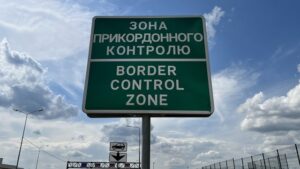
Passenger traffic across the Ukrainian border in the sixth week of autumn, from October 4 to 10, decreased by 8.2% to 515,000, according to data from the State Border Guard Service.
According to it, the number of arrivals to Ukraine during the week decreased from 278,000 to 253,000, while the number of departures fell from 283,000 to 262,000.
The number of vehicles passing through border checkpoints also decreased to 129,000 from 137,000, while the flow of vehicles carrying humanitarian cargo increased from 481 to 501.
As of 9:00 a.m. this Saturday, according to the State Border Guard Service, the largest queue on the border with Poland consisted of 45 cars at the Shehyni checkpoint, with another 35 cars waiting at Krakivets, 25 at Ustyluh, and 10 at Hrushiv.
On the border with Hungary, small queues of 10 cars were observed at the Tysa, Vylok, and Luzhanka crossings, with another 5 cars waiting at Kosyno, while on the border with Slovakia there was a queue only at the Uzhhorod checkpoint — 11 cars.
Finally, on the border with Romania, 15 cars accumulated at the Porubne checkpoint, while there were no queues at all other points, nor on the border with Moldova.
The total number of border crossings this week was, for the first time in a long while, lower than last year’s (by 1.3%), because last year during the same week pilgrims were leaving after celebrating Rosh Hashanah. Therefore, the number of those leaving the country was significantly higher than those entering — 272,000 versus 250,000 respectively. However, vehicle flow was lower then — 124,000.
Last year, passenger traffic remained at about this level until a slight increase during the autumn school holidays, after which it fell by about 20% before the Christmas and New Year holidays.
As reported, since May 10, 2022, the outflow of refugees from Ukraine that began with the start of the war was replaced by an inflow that lasted until September 23, 2022, totaling 409,000 people. However, since late September, possibly under the influence of news about mobilization in Russia and “pseudo-referendums” in occupied territories, and later massive shelling of energy infrastructure, the number of people leaving began to exceed those entering. From late September 2022 to the first anniversary of the full-scale war, this surplus reached 223,000 people.
During the second year of the full-scale war, the number of border crossings leaving Ukraine exceeded entries by 25,000, in the third year by 187,000, and since the beginning of the fourth year by 189,000.
As Serhiy Soboliev, then Deputy Minister of Economy, noted in early March 2023, the return of every 100,000 Ukrainians home adds 0.5% to GDP growth.
In its July inflation report, the National Bank worsened its migration forecast: while in April it expected a net inflow to Ukraine of 0.2 million people in 2026, it now forecasts a net outflow of 0.2 million, matching this year’s estimate. “Net return will begin only in 2027 (about 0.1 million people, compared to 0.5 million in the previous forecast),” the NBU added. In absolute terms, the NBU estimates the number of migrants currently abroad at about 5.8 million.
According to updated UNHCR data, the number of Ukrainian refugees in Europe as of October 3, 2025, was estimated at 5.192 million (5.138 million as of September 2), and worldwide at 5.753 million (5.696 million).
Within Ukraine itself, according to the latest UN data from July this year, there were 3.340 million internally displaced persons (IDPs), compared to 3.757 million in April.

Intense fighting broke out between Afghan and Pakistani forces on the border between Afghanistan and Pakistan, marking one of the most serious escalations in recent years.
According to reports from the Afghan side, 58 Pakistani soldiers were killed during night operations, and 25 border posts were captured. Pakistani authorities confirm the deaths of 23 of their soldiers and claim significant losses on the Afghan side, exceeding 200 people.
Pakistan cites air strikes on its targets in Kabul and eastern Afghanistan, including strikes on suspected Tehreek-i-Taliban Pakistan (TTP) positions, as the cause of the conflict. The Afghan side claims that in response to repeated violations of its airspace by Pakistan, it launched an operation to capture border positions.
As a result of the intensification of fighting, the Pakistani authorities closed key border crossings — Torkham and Chaman, as well as a number of smaller border crossings.

Imports of goods from Ukraine in January-September 2025 amounted to $60.1 billion in monetary terms, which is 17.4% higher than in the same period of 2024, while exports decreased by 3.1% to $29.5 billion, according to the State Customs Service (SCS).
“At the same time, taxable imports amounted to $45.9 billion, which is 76% of the total volume of imported goods. The tax burden per 1 kg of taxable imports in January-September 2025 was $0.52/kg,” the agency’s Telegram channel reported on Wednesday.
Traditionally, China imported the most goods to Ukraine – $13.3 billion, followed by Poland – $5.7 billion, and Germany – $4.8 billion.
Ukrainian goods were exported mainly to Poland – $3.7 billion, Turkey – $2.1 billion, and Germany – $1.8 billion.
Of the total volume of goods imported into the country in January-September 2025, 69% of the categories were machinery, equipment, and transport – $23.8 billion (with customs clearance, UAH 148.3 billion, or 29% of customs payments, was paid to the budget), chemical industry products – $9.4 billion (72.9 billion hryvnia paid to the budget, or 14% of revenues), fuel and energy – $7.6 billion (146.6 billion hryvnia paid, accounting for 29% of customs payments).
According to the State Customs Service, the top three most exported Ukrainian goods were food products – $16.2 billion, metals and metal products – $3.4 billion, and machinery, equipment, and transport – $2.8 billion.
“In the first nine months of 2025, UAH 641.9 million was paid to the budget during customs clearance of exports of goods subject to export duties,” the service concluded.

Passenger traffic across Ukraine’s border in the fifth week of autumn, from September 27 to October 3, decreased by 5.2% to 561,000, according to data from the State Border Service.
According to the data, the number of arrivals in Ukraine during the week decreased from 286,000 to 278,000, while the decrease in the outbound flow was more significant – from 306,000 to 283,000, which is explained by the end of the Jewish New Year “Rosh Hashanah” celebrations last week and the departure of pilgrims from Ukraine.
At the same time, the number of vehicles that passed through checkpoints increased from 133,000 to 137,000, while the flow of vehicles carrying humanitarian cargo remained approximately the same – 481.
This Sunday, as of 6:00 p.m., according to the State Border Service, the longest queue of 50 passenger cars was at the Ustyluh checkpoint, another 15 cars were waiting to cross the border at the Uhryniv checkpoint, and 10 cars had accumulated at the Shehyni checkpoint.
At the border with Hungary, there were queues of 20 cars at the Tisa and Luzhanka checkpoints, another 15 cars were waiting at the Vilok checkpoint, while at the border with Slovakia, there were queues of 15 cars at the Uzhgorod and Maly Berezny checkpoints.
At the border with Romania, there was a queue of 20 cars only at the Porubne checkpoint, while at the border with Moldova, 15 cars were waiting at the Mamalyga checkpoint.
The total number of border crossings this week is only 3.7% higher than last year, because then pilgrims came to celebrate Rosh Hashanah mainly during this week. Therefore, the number of those who left the country was less than the number of those who entered – 256 versus 285, respectively. The flow of cars was also lower – 128,000.
Last year, passenger traffic remained at approximately this level until a small surge during the autumn school holidays, after which it fell by about 20% until the Christmas and New Year holidays.
As reported, from May 10, 2022, the outflow of refugees from Ukraine, which began with the start of the war, was replaced by an influx that lasted until September 23, 2022, and amounted to 409,000 people. However, since the end of September, possibly influenced by news of mobilization in Russia and “pseudo-referendums” in the occupied territories, followed by massive shelling of energy infrastructure, the number of those leaving exceeded the number of those entering. In total, from the end of September 2022 to the first anniversary of the full-scale war, it reached 223,000 people.
During the second year of the full-scale war, the number of border crossings to leave Ukraine, according to the State Border Service, exceeded the number of crossings to enter by 25,000, during the third year by 187,000, and since the beginning of the fourth year by 180,000.
As Serhiy Sobolev, then Deputy Minister of Economy, noted in early March 2023, the return of every 100,000 Ukrainians home results in a 0.5% increase in GDP.
In its July inflation report, the National Bank worsened its migration forecast: while in April it expected a net inflow of 0.2 million people to Ukraine in 2026, it now forecasts a net outflow of 0.2 million, which corresponds to the estimate of the net outflow this year. “Net return will only begin in 2027 (about 0.1 million people, compared to 0.5 million in the previous forecast),” the NBU added. In absolute terms, the National
Bank estimates the number of migrants currently remaining abroad at about 5.8 million.
According to updated data from the UNHCR, the number of Ukrainian refugees in Europe as of October 3, 2025, was estimated at 5.192 million (as of September 2 – 5.138 million), and globally – at 5.753 million (5.696 million).
In Ukraine itself, according to the latest UN data for July this year, there are 3.340 million internally displaced persons (IDPs), compared to 3.757 million in April.

The Cabinet of Ministers of Ukraine has updated the procedure for crossing the state border: men aged 18 to 22 will be able to cross the border without hindrance during martial law, Prime Minister Yulia Svyrydenko said.
“This applies to all citizens of the relevant age,” she wrote on Telegram.
According to the head of government, this decision also applies to citizens who, for various reasons, find themselves abroad. We want Ukrainians to maintain their ties with Ukraine as much as possible. The changes will take effect the day after the resolution is officially published.

Passenger traffic across Ukraine’s border from August 16 to 22 amounted to 768,000, which is 1.3% less than the record level for wartime in the previous two weeks, according to data from the State Border Service on Facebook.
According to the data, while in the previous four weeks the number of people entering the country exceeded the number of people leaving by 15,000-32,000, with the approach of the new school year, the numbers evened out: the number of people leaving increased from 378,000 to 385,000, while the number of people entering decreased from 400,000 to 383,000.
The number of vehicles that passed through checkpoints this week increased from 144,000 to 145,000, while the flow of vehicles carrying humanitarian cargo decreased from 524 to 449.
This Sunday, as of 9:00 a.m., according to the State Border Service, the longest queue of 55 cars and 4 buses was at the Ustyluh checkpoint on the border with Poland. Forty cars and four buses were waiting to cross the border at the Krakivets checkpoint, while 19 buses had accumulated at the Shehyni checkpoint.
On the border with Hungary, the longest queue of 45 cars was at the Kosyno crossing, while at the Luzhanka checkpoint there were 30 cars, at Dzvinkove – 20, and at Tisa – 15.
At the border with Slovakia, 30 and 20 cars were waiting for inspection at the Uzhhorod and Malyi Berezny checkpoints, respectively, while at the border with Romania, there was only a queue of 30 cars at the Dyakove checkpoint.
The total number of people crossing the border this year is 4.2% higher than last year: during the same seven days last year, 370,000 people left Ukraine and 367,000 entered, and the flow of cars was also lower – 133,000.
As reported, from May 10, 2022, the outflow of refugees from Ukraine, which began with the start of the war, was replaced by an influx that lasted until September 23, 2022, and amounted to 409,000 people. However, since the end of September, possibly influenced by news of mobilization in Russia and “pseudo-referendums” in the occupied territories, followed by massive shelling of energy infrastructure, the number of those leaving exceeded the number of those entering. In total, from the end of September 2022 to the first anniversary of the full-scale war, it reached 223,000 people.
During the second year of the full-scale war, the number of border crossings to leave Ukraine, according to the State Border Service, exceeded the number of crossings to enter by 25,000, during the third year by 187,000, and since the beginning of the fourth year by 116,000, of which 80,000 were seasonal since the beginning of summer.
As Deputy Minister of Economy Serhiy Sobolev noted in early March 2023, the return of every 100,000 Ukrainians home results in a 0.5% increase in GDP.
In its July inflation report, the National Bank of Ukraine worsened its migration forecast: while in April it expected a net inflow of 0.2 million people to Ukraine in 2026, it now forecasts a net outflow of 0.2 million, which corresponds to this year’s estimate of net outflow. “Net returns will only begin in 2027 (about 0.1 million people, compared to 0.5 million in the previous forecast),” the NBU added. In absolute terms, the National Bank estimates the number of migrants currently remaining abroad at about 5.8 million.
According to updated UNHCR data, the number of Ukrainian refugees in Europe as of July 31, 2025, was estimated at 5.115 million (as of July 1 – 5.083 million), and worldwide – at 5.676 million (5.643 million).
In Ukraine itself, according to the latest UN data for April this year, there are 3.757 million internally displaced persons (IDPs), compared to 3.669 million at the end of last year.